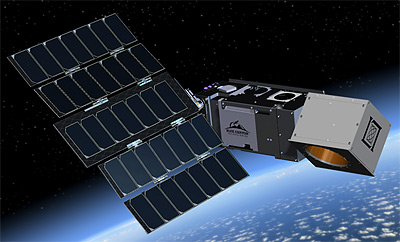Thank you very much for visiting Gunter's Space Page. I hope that this site is useful and informative for you.
If you appreciate the information provided on this site, please consider supporting my work by making a simple and secure donation via PayPal. Please help to run the website and keep everything free of charge. Thank you very much.
TROPICS

TROPICS [MIT]
TROPICS (Time-Resolved Observations of Precipitation structure and storm Intensity with a Constellation of Smallsats) is a constellation of seven identical 3U CubeSats provide sounding with 30-minute median revisit rate.
Each TROPICS CubeSat, based on the MicroMAS and MicroMAS 2a, 2b satellites, is a dual-spinning 3U CubeSat equipped with a 12-channel passive microwave spectrometer providing imagery near 90 and 206 GHz, temperature sounding near 118 GHz, and moisture sounding near 183 GHz. Each CubeSat comprises a 2U spacecraft bus with ADCS, avionics, power, and communications, and a 1U spinning passive radiometer payload with highly integrated, compact microwave receiver electronics. Initially, a constellation of twelve satellites was planned, but it has been reduced to seven.
The science objectives of the mission are:
- Relate precipitation structure evolution, including diurnal cycle, to the evolution of the upper-level warm core and associated intensity changes
- Relate the occurrence of intense precipitation cores (convective bursts) to storm intensity evolution
- Relate retrieved environmental moisture measurements to coincident measures of storm structure (including size) and intensity
- Assimilate microwave radiances and/or retrievals in mesoscale and global numerical weather prediction models to assess impacts on storm track and intensity
This observing system offers an unprecedented combination of horizontal and temporal resolution to measure environmental and inner-core conditions for tropical cyclones (TCs) on a nearly global scale and is a profound leap forward in the temporal resolution of several key parameters needed for detailed study of high-impact meteorological events (TCs being the primary emphasis in this proposal). TROPICS will demonstrate that a constellation approach to earth Science can provide improved resolution, configurable coverage (tropics, near global, or global), flexibility, reliability, and launch access at extremely low cost, thereby serving as a model for future missions.
The TROPICS constellation will be formulated with four CubeSats in each of three orbital planes with the following launch parameters: equally spaced RAAN (▒30░ tolerance), 600 km altitude (550▒50 km tolerance), 30░ inclination (▒3░ tolerance). These mission parameters will meet science requirements should the threshold number of CubeSats (eight) be implemented. Analyses have shown orbit lifetime of 9 years, well over the expected mission lifetime of one year and well in advance of the 25-year de-orbit requirement. This configuration yields 30-minute median revisit rates with average spatial resolution better than precipitation and all-weather temperature and humidity (PATH) requirements, all from a low-cost, low-risk CubeSat constellation platform.
Blue Canyon Technologies received a contract to build seven identical XACT-based 3U-class CubeSats. One was launched as a pathfinder for checkout and optimization of all mission elements prior to the primary six satellite constellation.
| Nation: | USA |
|---|---|
| Type / Application: | Earth observation, technology |
| Operator: | Massachusetts Institute of Technology - Space Systems Laboratory (MIT SSL) |
| Contractors: | Blue Canyon Technologies, Massachusetts Institute of Technology - Space Systems Laboratory (MIT SSL) |
| Equipment: | 12 channel passive microwave radiometer |
| Configuration: | CubeSat (3U) |
| Propulsion: | None |
| Power: | Deployable solar array, batteries |
| Lifetime: | 1 year (planned) |
| Mass: | 5.3 kg |
| Orbit: | 524 km × 536 km, 97.51░ (#1); 600 km × 600 km, 30░ (#2-7) |
| Satellite | COSPAR | Date | LS | Launch Vehicle | Remarks | |
|---|---|---|---|---|---|---|
| TROPICS 01 (TROPICS Pathfinder) | 2021-059Y | 30.06.2021 | CC SLC-40 | Falcon-9 v1.2 (Block 5) | with Starlink v1.5 R1-1, ..., R1-3, Umbra-SAR 2001, YAM 2, YAM 3, ĐuSat 19, ..., 22, ICEYE X11, X12, X13, X15, TUBIN, Mandrake 2A, 2B, Capella 5, GNOMES 2, LINCS 1, 2, PACE 1, D2/AtlaCom 1, EG 3, Centauri 4, Lemur-2 140, ..., 145, SpaceBEE 88, ..., 111, SpaceBEENZ 7, ..., 10, Sherpa-FX 2, Lynk 06, Hawk 3A, 3B, 3C, Astrocast 0201, ..., 0205, Painani 2, Sherpa-LTE 1, Tenzing, Aurora, Arthur 1, Faraday Phoenix, KSF 1A, ..., 1D, Tiger 2, ION-SCV 003, NAPA 2, Spartan, Neptuno, W-Cube, Ghalib, QMR-KWT | |
| TROPICS 02 | 2022-F03 | 12.06.2022 | CC SLC-46 | F | Astra Rocket-3.3 | with TROPICS 04 |
| TROPICS 03 | 2023-073B | 26.05.2023 | OnS LC-1B | Electron KS | with TROPICS 07 | |
| TROPICS 04 | 2022-F03 | 12.06.2022 | CC SLC-46 | F | Astra Rocket-3.3 | with TROPICS 02 |
| TROPICS 05 | 2023-062A | 08.05.2023 | OnS LC-1B | Electron KS | with TROPICS 06 | |
| TROPICS 06 | 2023-062C | 08.05.2023 | OnS LC-1B | Electron KS | with TROPICS 05 | |
| TROPICS 07 | 2023-073C | 26.05.2023 | OnS LC-1B | Electron KS | with TROPICS 03 |
References:
- VCL (ESSP 1) - cancelled
- GRACE (ESSP 2)
- CALIPSO (ESSP 3)
- Cloudsat (ESSP 4)
- OCO, OCO 2 (ESSP 5)
- Aquarius (ESSP 6)
- Hydros (ESSP 7) - cancelled
- OCO 3 (ESSP 8)
- CYGNSS (ESSP EVM1)
- GeoCARB (ESSP EVM2)
- INCUS (ESSP EVM3)
- TEMPO (ESSP EVI1)
- ECOSTRESS (ESSP EVI2)
- GEDI (ESSP EVI2)
- MAIA (ESSP EVI3)
- TROPICS (ESSP EVI3)
- PREFIRE (ESSP EVI4)
- EMIT (ESSP EVI4)
- GLIMR (ESSP EVI5)
